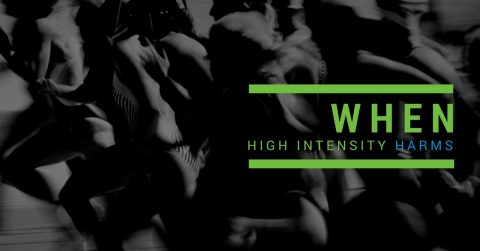
I’ve been getting a very similar question/story lately. It goes something like this.
I’ve been eating paleo for months, doing high intensity exercise, doing everything right, and I still can’t drop the weight, I’m still fighting fatigue, and I’m ready to give up.
That statement in itself could mean a lot of things but for the sake of this post, I want to focus on the high intensity exercise piece.
I LOVE high intensity exercise. I do high intensity workouts in a CrossFit manner. But exercise is actually one of the poorest interventions for you to lose weight. Why? Because most measure exercise in terms of calorie expenditure. I don’t really want to get into the calorie-in, calorie-out falsehood of activity and weight. Instead, I’m going to focus on the bigger picture.
Get Nervous
If you want to the most out of your fitness routine, you have to make it congruent with your nervous system. Your nervous system has 2 basic sides: Protection and Growth. And if you’ve read anything of mine in the past, you know I love Bruce Lipton’s quote, “You can’t be in growth and protection at the same time.”
Even though you can’t be in growth and protection at the same time, this doesn’t mean you don’t get the full benefit of either side in the same day, or even in the same minute.
Let’s say you’re out for a walk with your dog and you spot a mountain lion lurking up to the side of you stalking you. This would be a moment you definitely want your nervous system to shift into protection mode. Your brain sends hormones to the adrenals to active cortisol and catecholamines. Cortisol quickly acts to dump sugar from your storage into your blood stream. The catecholamines act on your cardiac output and muscle contraction to prep you for what may happen next.
This protection side of life actually puts you in a catabolic state (tissue break down). The more you demand this side of your nervous system to activate throughout the day, the more your body breaks down. In other words, the more stress you are under (physically, chemically, emotionally, socially, spiritually, etc), the more you keep throwing your body into break down mode.
After a while, you realize you are getting more and more tired, you’re achy, and the weight starts packing on and something has to change.
But if your body is in tissue breakdown mode, why would you actually gain weight? Again, there could be a number of answers. I will simplify this answer to the two biggies of insulin and inflammation.
Fanning the Flames
If you have the typical American busy, toxic, socially isolated lifestyle (even though you eat paleo), your body will favor protection and tissue breakdown to keep you going. The body will do everything in its power to keep you alive the next 30 seconds, even if it’s at the expense of the next 30 years. One of those mechanisms is to dump sugar from stored areas into your blood stream. This is an extremely intelligent action to help you survive.
Your body also has the intelligence to look at the elevated blood sugars and realize that’s not a good plan long term. As a result, insulin gets released to take up the excess sugar and store it. The first place to store excess sugar is in the liver but there’s a small limit and once it reaches that limit, your liver puts the ear plugs on and doesn’t listen to insulin’s pleas anymore. Your muscles are the same; only about a day’s worth of stored energy before they tune out insulin.
The sugar must be stored somewhere so it looks for fats and attaches the sugars to those fat molecules. You know these as triglycerides. Eventually these triglycerides are stored as fat in the non-exclusive club we call the butt, gut, and thighs. Since the excess sugar is stored as fat, this is why fat has been attacked for the past 40 years.
If the constant attacks on your lifestyle were real threats like mountain lions where you actually have to run or fight as hard as possible, you would utilize those energy releases. The problem is that most of your daily stresses are happening while you’re sitting on the very structure you’re trying to reduce, your arse. Though insulin is a growth hormone, when it’s out of control, it ironically is a massively powerful promoter of your sympathetic nervous system (#protection, #catabolic #tissuebreakdown #cantloseweight).
But Wait, There’s More
If you have kids, you know sugar is sticky. It especially likes to stick to proteins (think bubble gum in the hair). This process of glucose sticking to proteins is very important in your weight loss journey and part of the reason why high intensity harms. This process of sugar and protein shacking up is called glycation. This process damages the protein to the extent that white blood cells will come around and attack it to try and get rid of it.
Just to remind you, your white blood cells mediate your immune response. Part of that response is to induce a little helper called inflammation. The more damage you induce, the more inflammation is produced to repair you. The problem is that you ignore these signals and continue to push life forward. This keeps you in a perpetual state of running from lions, opposed to supporting metabolism.
When High Intensity Harms
You are at a breaking point and you hear a conversation at work that someone is having fantastic results with high intensity exercise. You’ve noticed the changes in their appearance, their attitude, and you want that. You decide to go for it. You hire a trainer, join a box, or buy a home workout routine that is designed for high intensity. A few months go by and you’re drained, you haven’t lost weight, and contemplating hormone replacement because you think, ‘it might be my thyroid.’
Instead, assess if your workout routine is congruent with your nervous system. When there are contradictions, there will be destruction. Here are some contradictions in your high intensity routine you may want to consider.
Time Out
With high intensity training, I think everyone forgets it should also be SHORT duration. If you have a mountain lion breathing down your neck, you’re going all out, max effort. There is no pacing. It’s go time. It’s you or the dog. I often see people boasting of high intensity routines that last 30-45 minutes. That’s NOT high intensity. That’s long drawn out cardio. If you can keep a pace of movement for longer than 8-10 minutes, you’re not going hard enough to call it high intensity.
My workout yesterday was 4 minutes and 58 seconds. Today, it was 7 minutes and 40 seconds. Yes, sometimes I have the 40 minute long session but that’s the minor exception, not the rule. Scaling your load and repetitions is encouraged. Or dive into weight lifting. Move heavy stuff to the point of failure.
Timing
Your normal daily awake cycle should start off energized and end being tired. This is the normal hormonal cycle of Cortisol. Cortisol should be high in the morning to give you energy to get you out of bed and ready for the day and decline through the day to make sure you can settle down when it’s dark and get to sleep.
I see a lot of hangups with the timing of a high intensity workout. It’s rush, rush, rush all day with busyness and when you should be settling down to allow your body to recover, you hit the gym instead. The gym is filled with bright lights and pumped up music (a high alert environment).
Because you’ve had a busy day, you may have even grabbed a coffee before your workout so you can reach max effort. You’re doing great at overriding your innate intelligence but eventually that innate intelligence will win out. Your nervous system wants to slow down, yet you’re doing everything possible to speed it back up. This just perpetuates the cycle of escaping lions. With enough time, rest will find you instead of you finding rest. Your body will intentionally slow you down since you’re not consciously doing it for yourself.
Work with your nervous system, not against it. You should naturally have more energy in the morning. Ever wonder why most hunting creatures are nocturnal and humans aren’t? Humans would never survive if we had to hunt in the dark.
[bctt tweet=”Humans would never survive if we had to hunt in the dark.” username=”DrKurtDC”]
If you really want a workout after work, do something more restorative like mobility or yoga that won’t send your heart rate racing and your adrenals on alert. Getting up in the morning may mean you have to drastically change your evening schedule. My success in a morning routine is by keeping it boring in the evening.
After I get home from the office, we eat dinner together at about 6:30 pm, play with the boys for a bit, get them ready for bed, and then totally veg out. I often lay on the floor doing some mobility and watch some brainless NetFlix with my wife. I’m a sucker for the shows with a high school setting like Friday Night Lights and One Tree Hill. If only NetFlix had Dawson’s Creek.
Cheater Cheater Booger Eater
When people do high intensity exercises, this often speeds up the mechanics of the movement. We use speed to cheat. To be clear, there’s nothing wrong with going fast. But when going fast makes you cheat your full movement, this has the potential to trick your brain into thinking something is wrong. The more you can place your body in full ranges of motion, the more your brain equates that movement with benefit.
If you’re running from that mountain lion (poor choice, you’re not that fast), who cares what your form looks like. You’re willing to sacrifice the next 30 years to stay alive the next 30 seconds. But when you’re willingly put yourself in repeated high intensity, poor movement scenarios, your body’s position will give signals to your brain that it’s potentially injured.
The more you limit that full range of motion, the more your body sends protection signals to your brain. But the more you are able to drop into a full squat or get your chest to the floor on a pushup, your brain recognizes it as beneficial. Smooth is fast. The better your quality of movement, the more relaxed the brain is, which helps you shift into recovery mode after the workout. For you CrossFitters, it’s ok to scale (this might be more of a reminder for me than you).
For the No Intensity Crowd
I’m sure there a few out there that do nothing and will read this and use it as a case against doing high intensity workouts. Please don’t. In fact I would encourage you to try it. Even if you’re bound to a wheel chair, you can punch the air in front of you. For those brand new to a high intensity, SHORT DURATION, movement routine, follow the timing, time, and booger eater tips to make it successful. I would also encourage you to try it in a 4 minute routine called a TABATA.
It’s 4 minutes of alternating cycles of 20 seconds of intense work, followed by 10 seconds of rest. Punch a pillow, raise the roof, or stomp your feet. Just do it as fast and with full motion as possible in those 20 seconds of work, preferably in the morning.
Complicating Factors
If you’re already doing these above steps and having road blocks, then often times there are other circumstances that aren’t externally obvious and need further digging and investigation. I can help, you just have to come find me.


1 Comment